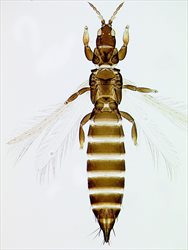
Female

Antenna

Antennal segments I-IV
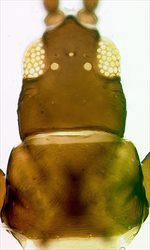
Head & pronotum
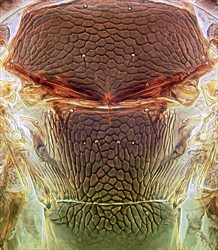
Meso & metanota
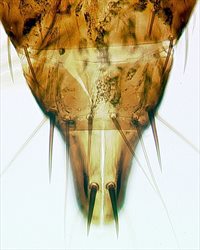
Female tergites VIII-X
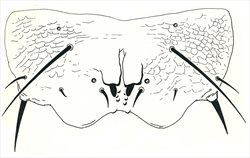
Male tergite IX

Fore wing
Female macroptera. Body brown, tarsi paler, antennal segment III light brown with pedicel yellow; fore wings light brown. Antennae 8-segmented; III with external margin produced into a tooth; sense cone simple on III but forked on segment IV. Head longer than wide, distinctly projecting in front of eyes; with 2–3 pairs of ocellar setae, pair III anterolateral to ocellar triangle, scarcely longer than distance between two ocelli; postocular setae small; maxillary palps 2-segmented. Pronotum with 1 pair of long posteroangular setae, posterior margin with 3 pairs of setae. Metanotum reticulate, campaniform sensilla present, median setae arise behind anterior margin. Meso- and metafurca without spinula. Fore wing first vein with 2 setae on distal half, second vein with about 10 setae. Tergites reticulate medially, paired campaniform sensilla close to posterior margin, craspedum not developed; tergite X with 1 pair of stout thorn-like setae. Sternites II–VII with 10–16 discal setae, without craspeda.
Male aptera. Head without ocelli; pterothorax transverse without wing buds; tergite IX with 2 pairs of small stout setae on tubercles, 1 pair medially, 1 longer pair laterally; sternites without pore plates.
Although eight species are listed in the genus Limothrips, no more than six of these are likely to be valid (zur Strassen, 2003). They all live on various grasses, and are distinguished from other grass-living Thripinae by the stout pair of thorn-like setae at the apex of the tenth abdominal segment. Although they are originally from Europe, three species are now widespread around the world. L. denticornis is distinguished by the strong lateral prolongation of the external margin of antennal segment III.
Feeding and breeding on the leaves and in the flowers of many Poaceae including cereal crops, particularly Avena.
Recorded across Britain from Kent to Inverness, and also from both Northern Ireland and the Republic of Ireland (Mound et al., 1976; O'Connor, 2008), this species is abundant in Europe and its range extends as far southeast as Iran. It has been introduced to North America (Stannard, 1968) and to Australia.
THRIPIDAE - THRIPINAE
Limothrips denticornis (Haliday)
Thrips (Limothrips) denticornis Haliday, 1836: 445
Thrips kollari Heeger, 1852: 484
Thrips (Limothrips) bidens Reuter, 1879: 212
Thrips secalina Lindeman, 1887: 301
Limothrips denticornis ab. adustus Priesner, 1920: 52
Limothrips incertis Bagnall, 1926: 462
Mound LA, Morison GD, Pitkin BR & Palmer JM (1976) Thysanoptera. Handbooks for the Identification of British Insects 1 (11): 1–79.
O’Connor JP (2008) A review of the Irish thrips (Thysanoptera). Irish Naturalists’ Journal 29: 20–24.
Stannard LJ (1968) The thrips, or Thysanoptera, of Illinois. Bulletin of the Illinois Natural History Survey 29: 213–552.
zur Strassen R (2003) Die terebranten Thysanopteren Europas und des Mittelmeer-Gebietes. Die Tierwelt Deutschlands 74: 1–271.